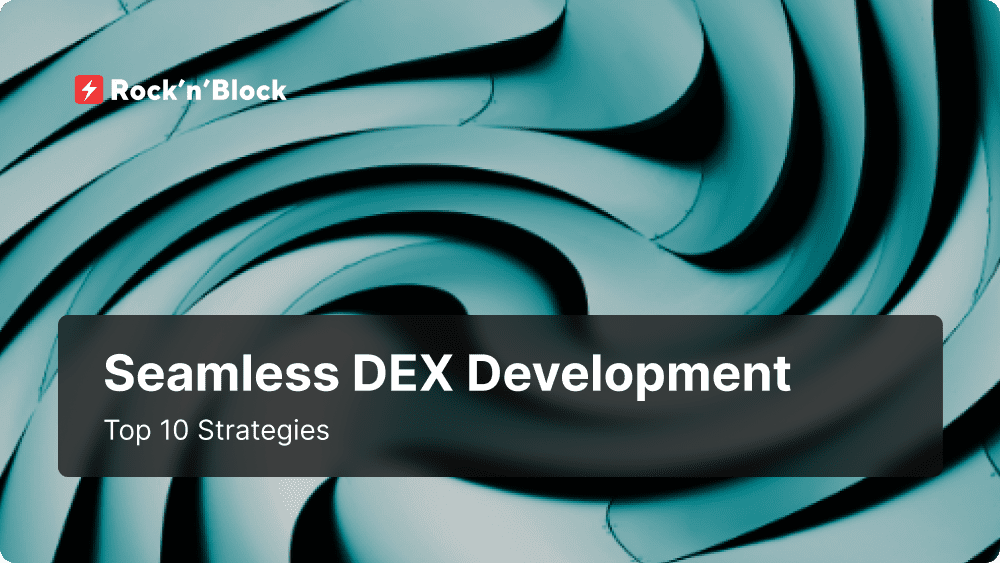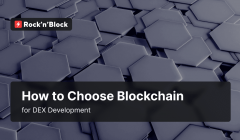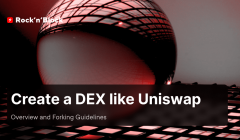Top 10 Strategies for Seamless DEX Development
03 May 2024Decentralized Exchanges (DEX) are a cornerstone of the rapidly evolving landscape of decentralized finance (DeFi). As demand for trustless and permissionless trading solutions continues to rise, the DEX platforms development has become a key point for both blockchain enthusiasts and developers. This article explores key strategies that enable seamless DEX development, unlocking the full potential of DeFi ecosystems.

Table of Contents:
-
The Significance of DEX in Decentralized Finance
-
Strategies for Seamless DEX Development
-
1. Overview of the Current DEX Landscape
-
2. Comprehensive Research and Analysis
-
3. Research Existing Blockchain Platforms
-
4. Smart Contract Security
-
5. User Experience (UX) Design
-
6. Liquidity Mining and Incentives
-
7. Interoperability
-
8. Community Engagement
-
9. Regulatory Compliance
-
10. Post-Deployment Continuous Innovation
-
Conclusion
The Significance of DEX in Decentralized Finance
In the dynamic landscape of DeFi, decentralized exchanges (DEX) stand as beacons of innovation, challenging traditional financial norms.
The Evolution of Decentralized Finance
Traditional financial systems have long been challenged by intermediaries, slow transaction processes and limited accessibility. The emergence of DeFi represents a shift in paradigm, highlighting transparency, inclusivity and elimination of financial obstacles.
The central concept of this transformative movement encompasses decentralized exchanges. The DEX functions without a central authority by utilizing smart contracts to enable secure and efficient peer-to-peer trading. These platforms automate processes, eliminating the necessity for intermediaries, and prediction a new epoch of trustless transactions.
Advantages of DEX in Decentralized Finance
DEX development presents various benefits that enhance its significance in the world of DeFi. By eliminating intermediaries, improving security measures, and offering 24/7 accessibility, DEX platforms enable users to take control of their financial journeys.
An essential advantage of decentralized exchange development is the enhanced security features that come with the use of unmodified blockchain technology, minimizing the threat of hacks compared to centralized exchanges.
Strategies for Seamless DEX Development
Let’s explore key strategies that can contribute to the seamless DEX development, unlocking the full potential of decentralized financial ecosystems. Whether you're a seasoned developer or a blockchain enthusiast, these strategies will serve as a roadmap to navigate the intricate landscape of DEX development, ensuring your decentralized exchange stands out in the dynamic world of cryptocurrency trading.
1. Overview of the Current DEX Landscape
Successful decentralized exchange development demands an in-depth understanding of the existing decentralized exchange landscape. Evaluate the strengths and weaknesses of established platforms and detect any deficiencies or prospects for enhancement.
For example, top DEXs like Uniswap, SushiSwap, and PancakeSwap use automated market makers (AMMs) to provide liquidity. Although Ethereum is a popular blockchain choice for DEX development, scalability troubles have led to the emergence of multi-chain solutions. Binance Smart Chain, Polygon, and Solana are becoming increasingly prominent, providing quicker and more cost-effective transactions.
Read more about the DEX landscape in our in-depth article: Exploring Decentralized Exchange Development Landscape!
2. Comprehensive Research and Analysis
Thorough research is essential before embarking on DEX platform development. Analyze market trends and user preferences, and learn from both successful and failed case studies. This critical research will inform the key decisions made during the DEX development process.
Target Audience Analysis: the analysis of the target audience is necessary to define the target market. Understanding user needs, preferences, and pain points informs development, ensuring alignment with market demands.
Technical Considerations: vital for choosing the right blockchain, smart contract language and consensus mechanism. This ensures that the DEX is not only cutting-edge but also scalable and secure.
Competitor Analysis: analyzing competitors aids in identifying opportunities and differentiating factors. Understanding what works well in existing DEX platforms and what can be improved upon informs the creation of a more robust and user-friendly solution.
3. Research Existing Blockchain Platforms
Exploring cutting-edge approaches to blockchain integration is a crucial aspect of decentralized exchange development that stands out in the competitive landscape. The choice of a particular blockchain technology has significant implications for the project's financial outlook. Specific blockchain platforms use different technologies and programming languages, and developers competent in specific languages often command different rates. The selection of blockchain has a direct impact on the DEX development costs due to unique skill demands and operational costs of each platform.
Learn Key Selection Criteria for Choosing Blockchain for Decentralized Exchange Development and create your perfect DEX platform!
4. Smart Contract Security
DEX platforms heavily rely on smart contracts, and any vulnerabilities can lead to disastrous consequences.
The Role of Smart Contracts in DEX Development
Smart contracts serve as digital architects, executing and automating key functions such as order matching, asset swapping, and liquidity provision. Understanding the pivotal role of smart contracts is essential:
-
Fine-Tuned Automation
-
Identity Protection
-
Trustless Transactions
-
Enhancing Security
-
Decentralized Governance
-
Programmability and Flexibility
Read more about the role of smart contracts in DEX in our extensive guide: The Role of Smart Contracts in DEX Development!
Smart Contract Security
The security of smart contracts is essential for the integrity of any DEX platform development. It is necessary to implement best practices to protect user funds and ensure the robustness of the overall system.
Code Review and Quality Assurance: Review smart contract code for vulnerabilities, inefficiencies, and potential attack vectors. Following best coding practices and quality assurance standards will help identify and rectify issues before deployment.
Immutable Design: Ensure an unchangeable smart contract design once deployed. Implemented upon deployment to prevent unauthorized modifications, thus reducing the risk of exploits and ensuring the integrity of the contract's functionality.
Gas Optimization: Minimize gas usage to improve the cost efficiency of transactions. Gas-efficient smart contracts enhance user experience and attract more participants to the DEX platform.
Rigorous Audits
Smart contract audits are crucial in the blockchain sphere as they guarantee the safety, operation, and dependability of decentralized applications. By conducting thorough examinations, audits pinpoint weaknesses, minimize possible threats, and instill user trust, making them a necessary measure in preserving the reliability of smart contracts and, consequently, the wider decentralized ecosystem.
Implementing continuous monitoring mechanisms to detect and respond to potential security threats in real-time ensures that the DEX remains secure against evolving threats and challenges.
5. User Experience (UX) Design
In the world of decentralized finance, where user empowerment is paramount, the success of DEX platform development relies on exceptional User Experience (UX) design. This section explores how to create a user-friendly interface, the importance of prioritizing simplicity and intuitiveness, and integrating DeFi exchange features to enhance the overall user experience.
Creating a User-Friendly Interface
The interface serves as the entrance to the decentralized financial world, and its design greatly affects user engagement.
Intuitive Navigation: Design the interface with clear and intuitive navigation to ensure that users can easily find and access key features. An organized layout is crucial for creating a seamless user experience.
Clear Call-to-Actions: Clearly define call-to-action elements, guiding users on the steps to perform various transactions. Intuitive buttons, prompts, and menus enhance user understanding and streamline interactions.
Responsive Design: Prioritize responsive design to support users across devices and screen sizes. A responsive interface guarantees accessibility and usability, no matter which device is used to access the DEX platform.
Features Enhancing Overall User Experience
Enhancing the overall user experience involves incorporating features that go beyond basic functionalities.
Advanced Charting Tools: Offer users advanced charting tools to analyze market trends and make informed trading decisions. Personalized charts, technical indicators, and live data provide a more sophisticated trading experience.
Order Book Depth: Display a comprehensive order book that allows users to understand market liquidity and make informed trading decisions. An accessible order book increases user confidence in the platform.
Personalization Options: Integrate personalization features, allowing users to customize their dashboard, set preferences, and tailor the interface to their specific needs. Personalization enhances user engagement and satisfaction.
6. Liquidity Mining and Incentives
In the dynamic realm of decentralized exchange development, liquid assets are the key to a thriving ecosystem, and innovative strategies such as liquidity mining and incentives play a pivotal role.
Bootstrapping Liquidity through Incentive Programs
The efficient functioning of a decentralized exchange requires adequate liquidity, and incentive programs serve as tools for attracting liquidity providers. Crucial factors to consider in this regard are listed below.
Native Token Incentives: develop reward programmes that award participants with native tokens of the DEX platform. By doing so, you can attract liquidity providers whilst harmonizing their interests with the triumph and appreciation of the platform's native token.
Yield Farming Mechanisms: yield farming development offers users additional returns for providing liquidity. By enabling users to farm extra tokens by providing liquidity, DEX platforms can attract and retain liquidity in a competitive market.
Rewarding Early Adopters and Liquidity Providers
Recognizing and rewarding the early adopters and liquidity providers are essential for building a loyal and engaged community. Strategies for rewarding contributors are included in the list below.
Loyalty Programs: develop loyalty programs that offer additional incentives to users who have been part of the ecosystem from the beginning. These programs can offer extra benefits that increase over time to promote lasting engagement.
Tiered Rewards: implement tiered reward systems that provide elevated benefits to liquidity providers according to the amount and length of liquidity provided. This promotes sustained participation and recognises the contribution of key liquidity providers.
Innovative Tokenomics: develop innovative tokenomics that reward not only based on liquidity provision but also consider factors like trading volume, community engagement, and governance participation. This fosters a comprehensive reward system that appreciates diverse contributions.
7. Interoperability
The ability to interact with various blockchain networks expands the reach and utility of a DEX.
Importance of Interacting with Various Blockchain Networks
The blockchain landscape displays diversity with multiple networks providing exclusive features and assets.
Asset Diversity: various blockchain networks host a wide range of assets, each with its own unique characteristics. The implementation of interoperability facilitates DEX platforms to leverage this diversity, granting users access to a broader range of assets for trade.
Scalability and Efficiency: Interacting with various blockchain networks offers scalability benefits. DEX platform developers can leverage the strengths of different blockchains to enhance transaction throughput and reduce congestion, ensuring a more efficient trading experience for users.
Market Dynamics: Interacting with diverse blockchain networks empowers DEX platforms to adjust to shifting market dynamics. This incorporation of emerging blockchain technologies and assets maintains the platform's relevance and competitive edge.
Cross-Chain Compatibility for Seamless Asset Trading
Cross-chain compatibility is a cornerstone of decentralized exchange development, enabling seamless asset trading across different blockchain networks. Key aspects of this include:
Atomic Swaps: Implementing atomic swaps facilitates trustless and secure cross-chain transactions. Users can trade assets directly from one blockchain to another without the need for intermediaries or custodians.
Smart Contract Standards: Adhering to widely accepted smart contract standards across different blockchains ensures compatibility. Standards such as ERC-20 and BEP-20 enable the seamless token wrapping to Ethereum and Binance Smart Chain standards, fostering interoperability.
Decentralized Oracles: Integrating decentralized oracles provides accurate and real-time information about cross-chain asset prices. This ensures that users receive reliable data for executing trades and maintaining the integrity of the trading process.
Broadening User Base Through Interoperability
Interoperability enables decentralized exchange platforms to serve a worldwide audience. Traders from various blockchain communities can partake in transactions, cultivating a diverse and all-encompassing ecosystem.
By offering interoperability, DEX platforms reduce entry barriers for users who may be hesitant to engage with platforms exclusive to a single blockchain. This inclusivity encourages broader participation in decentralized finance.
8. Community Engagement
In the decentralized landscape, the success of DEX development extends beyond technological prowess; it hinges on community engagement.
Building a Supportive Community
A vibrant and engaged community is the heartbeat of a successful DEX platform.
Educational Initiatives: Promote comprehension and awareness by offering educational materials on decentralized finance, blockchain technology, and the unique elements of the DEX platform. A well-informed public is more inclined to partake actively.
Community Events: Organize and take part in community events, including AMAs (Ask Me Anything), webinars, and live Q&A sessions. These activities create chances for direct engagement, promoting a feeling of community and trust.
Social Media Presence: Maintain a consistent and interactive social media presence. Posting updates, creating engaging content, and promptly responding to comments and messages all aid in gaining visibility within the community and enhancing participation.
User Feedback Mechanisms: Actively seek and encourage user feedback regarding platform functionalities, features, and overall user experience. Regularly analyze this feedback to identify areas for improvement and innovation.
Responsive Support: Provide responsive and helpful customer support. Addressing user inquiries and concerns in a timely manner demonstrates a commitment to user satisfaction and fosters a positive community perception.
9. Regulatory Compliance
Navigate the regulatory landscape carefully to ensure long-term sustainability. Stay informed about evolving regulations of decentralized exchange development and work towards compliance without compromising the decentralized nature of your platform.
Regulatory challenges pose a nuanced landscape for DEX platforms, requiring careful consideration and strategic approaches:
Legal Landscape Assessment: conduct a thorough review of the legal landscape to comprehend the regulatory obligations across multiple jurisdictions. Diverse regions may adopt different strategies for crypto assets and decentralized exchanges.
Compliance with Securities Laws: Check the status of tokens listed on DEX to ensure compliance with securities laws. Tokens categorized as securities might face certain regulatory frameworks that can affect their listing and trading on the platform.
10. Post-Deployment Continuous Innovation
Continuous innovation and adaptation are crucial for success. To remain relevant and efficient, DEX developers must adopt a dynamic approach that caters to the changing requirements of the crypto community and the wider financial environment.
The launch of a decentralized exchange is just the beginning of the fast-moving world of decentralized exchange development. Post-deployment, DEX development enters a phase of continuous innovation, crucial for remaining competitive and relevant in the rapidly changing crypto landscape.
Dynamic Token Integrations: during the post-deployment phase, a successful DEX platform continually researches and integrates new tokens. Maintaining up-to-date knowledge of DeFi projects development and adhering to the community's preferences assures a varied assortment of assets available for users to trade.
Security Enhancements: DEX platforms must continuously enhance security measures to protect user funds and maintain trust. Regular security audits, bug bounty programs, and proactive responses to emerging threats are essential.
Liquidity Mining Innovations: liquidity is the lifeblood of any DEX. Post-deployment, successful platforms evolve their liquidity mining strategies to incentivize users and liquidity providers. This includes experimenting with different reward structures, collaborating with new projects for joint liquidity programs, and optimizing yield farming opportunities.
In conclusion, the post-deployment phase of DEX development is characterized by an ongoing commitment to innovation. By embracing change, staying connected with the crypto community, and actively responding to market dynamics, DEX platforms can not only thrive in the present but also lead the way in shaping the future of decentralized finance.
Conclusion
Successful and sustainable decentralized exchange development requires technical expertise, strategic planning, and a user-focused mindset. Developers can achieve this by conducting comprehensive research, prioritizing security, enhancing user experience, offering liquidity incentives, ensuring interoperability, engaging with the community, and complying with regulatory standards. As the DeFi sector expands, employing these tactics will be pivotal to moulding the future of decentralized finance.
We ❤️ Development
Follow us on social media to receive the hottest blockchain development updates
Crunchbase ⚡️ Twitter ⚡️ Telegram ⚡️ LinkedIn ⚡️ Facebook ⚡️ Zupyak ⚡️ Quora ⚡️ Reddit










